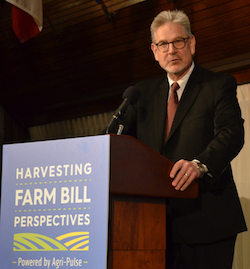 Tom Zacharias, president of National Crop Insurance Services (NCIS), was among the speakers invited to address this week’s Agri-Pulse Farm Bill Summit in Washington, D.C.
Tom Zacharias, president of National Crop Insurance Services (NCIS), was among the speakers invited to address this week’s Agri-Pulse Farm Bill Summit in Washington, D.C.
Zacharias stressed the role crop insurance plays in ensuring a strong and vibrant agricultural sector, which is critical to the well-being of our economy and society as a whole.
“The role of both state and federally regulated crop insurance is to help provide financial stability to the agricultural sector in combination with other farm-level risk management strategies such sound marketing and good financial planning, as well as other USDA programs designed to support American agriculture,” Zacharias said.
Zacharias noted that crop insurance is the “cornerstone” of the farm safety net, and highlighted a few of the program’s key components that have contributed to its success. These characteristics include the fact that crop insurance is contractually based, that farmers have “skin in the game” and that they only receive a crop insurance payment in the event of an insured loss.
Listen to his remarks here: Remarks from Tom Zacharias, President, National Crop Insurance Services
Photos can be found on the Agri-Pulse website.
Agri-Pulse Farm Bill Summit photos
Zacharias noted that since 1981, when the private sector was first tapped to deliver crop insurance, we have seen federal crop insurance grow from 45 million to 290 million acres.
In terms of financial protection, crop insurance protected about $6 billion worth of crops in 1981. Today that number is more than $100 billion.
Looking forward to the upcoming Farm Bill negotiations, Zacharias said, “We have an enormous task before us, but I believe a manageable one.”
The importance of a strong farm safety net, especially given the tough times in farm country, was a sentiment that was shared by many other speakers, which included all four leaders of the House and Senate Agriculture committees.
Providing an early outlook on the 2018 Farm Bill, the Summit also included panels on risk management, budget challenges, conservation, bridging the gap between farm and food policy and how to attract the next generation of farmers.
